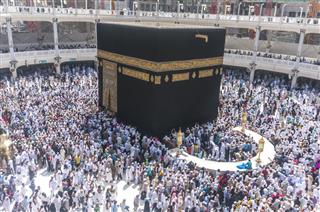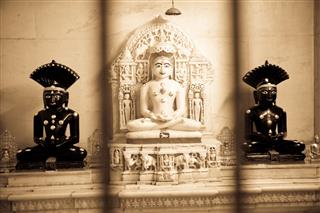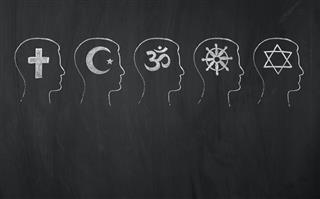
Each religion has its own unique set of principles and ethics, yet all of them unanimously preach universal peace and goodwill. Here’s a closer look at the different types of religions practiced by people around the world.
Halleluyah!
If you are in favor of free file-sharing, and worship CTRL+C and CTRL+V, you can become a member of world’s newest religion, Kopimism. The new file-sharing religion has recently got formal recognition from the Swedish government.
The very foundation of all existence is based on the belief of a primordial entity creating and regulating the universe, and its processes. This belief forms the core of the various religious ideologies that prevail all over the world. A basic question that pertains is regarding the exact definition of the term ‘religion’, the answer to which is not as simple as it seems. Religion is a very relative concept, and may mean different things to different people. However, one fundamental factor that is common throughout the various belief systems is that they have provided us with definite beings/entities, whom we can concentrate on, and venerate. Religion, in a nutshell, can thus be defined as ‘a system of beliefs and practices, which a person inherits at birth (sometimes by choice), and the norms of which, he is expected to follow all through his life, in order to lead a good and a fruitful existence, alongside gaining social acceptance’. Religion thus, not only defines who we are, but it also shapes our views with regards to the society, and the world.
Types of Religions
Religion has had obscure origins, and there are a lot of debates on how the religious practices and beliefs may have evolved over the ages. However, studies in cultural anthropology give us an idea about the possible origins of religious worship and practices. Three possible origins have been put forth viz.,
- the worship of superhuman powers of the natural forces such as thunder, lightning, flowing of water, growing of trees, and so on;
- the veneration of ancestral spirits, and;
- the propitiation and invocation of a singular, ultimate reality, which cannot be defined.
Bearing one of these probable origins, religion has come a long way today. Classifying religions into different categories is a difficult task, as every religion bears its own unique characteristic that one would not find in any other faith. Owing to this, it is better to consider each religion as a distinct set of beliefs, rather than grouping them under various categories.
Major World Religions
There are no exact statistics regarding the number of religions existing in the world, but recent estimates suggest that there may be about 4,200 different religions currently in practice. Some of the major world religions include the following:
Christianity
(approx. 2.1 billion followers)
Christianity, the monotheistic (belief in one God) and Abrahamic (tracing its origins to Abraham, a biblical patriarch found in Christianity, Judaism as well as Islam) religion, is one of the largest of the world religions, with followers spread across all the continents. When it originated in the middle of the first century, it was but a marginal sect of Judaism, limited to a small province called Levant, on the eastern boundary of the Roman Empire. However, by the fourth century, Christianity became the official religion of Roman Empire, replacing all the other faiths practiced before.
Christianity is based on the life, experiences, and teachings of Jesus Christ. It considers Jesus to be the Son of God. He is thus, a divine being born into the mortal world, and has both, divine as well as mortal affiliations. Owing to Jesus’ hypostatic character, he is both, the ‘prophet’ of the Almighty, and the ‘messiah’, who will save humanity. Added to this, there is a concept of Godhead in Christian faith, which says that within the personality of God, the Ultimate One, there are always three eternally co-existing characters viz., the Father (creator and controller of universe),the Son (Jesus Christ, the messiah), and the Holy Spirit (the transcendent reality that permeates the cosmos). The sacred book of the Christians is the Holy Bible, which features various canonical gospels, and other New Testament writings.
Today, owing to its vast geographical extent, the religion is characterized by internal divisions into various sects and denominations. These differences lie in fundamental issues such as origins, belief systems, theological matters, liturgy, etc. The largest sects of Christianity in the world include the Roman Catholic Church, the Eastern Orthodox Church, and the various Protestant churches. Worship, in many Christian traditions, comprises regular mass worship, sometimes complemented by individual prayer and meditation. There are also formal ceremonies held in the Church, on special occasions such as baptisms, weddings, and funerals.
Today, one in every three persons in the world is a Christian; that makes almost one-third of the world population. While Christianity is the official state religion of numerous nations such as Vatican City, Greece, England, and Denmark, Christians are also found in substantial numbers in other countries such as Turkey, Russia, India, France, and Iran.
Islam
(approx. 1.6 billion followers)

Islam is also a monotheistic Abrahamic religion, like Christianity. The followers of Islam are known as Muslims, and its teachings are lucidly expressed in the Qur’an, its sacred text. The words written in the Qur’an are considered to be the verbatim words of God himself, brought and taught to the mortals by His prophets. According to a Hadith (a statement of the Islamic prophet Muhammad), there were as many as 124,000 prophets send by God to spread his message, but only 25 of them have been mentioned in the Qur’an. However, Muhammad, the last Islamic prophet is important, in that he was attested the responsibility to convey the final word of God to the world.
Rigorous monotheism is the fundamental concept in Islam. Muslims believe that God, Allah, is the singular, eternal, and an absolute entity, who is formless, all-pervasive, and asexual. Because He is formless, the Muslims are not supposed to visualize God, or worship Him in any anthropomorphic/zoomorphic form. Added to this, the Muslims also believe in angels and demons (malāks and jinns), of which the former are heavenly beings, working on the order of God, recording the good and bad deeds of the mortals, and helping them, if need be. The latter, inhabit the unseen world that is invisible to the human eye, and may be both benevolent as well as malevolent. The Muslims also believe in the notion of the Day of Judgment (Al-Qiyāmah), when God will resurrect all the dead from their graves, and put them into heaven or hell, depending on their deeds.
Testimony (shahadah), prayer (salāh), giving of alms (zakāt), fasting (sawm), and pilgrimage (Hajj) are considered to be the five pillars of Islam, and every Muslim is expected to perform these acts in his life. Added to this, an ideal Muslim is expected to perform namāz (daily prayer) five times a day. Mecca, the birthplace of prophet Muhammad, is the holiest city of the Muslims, where the Kabba, their most sacred site is located. Medina is regarded as the second holiest city in Islam, as it was here that prophet Muhammad was buried. Apart from worshiping God, the Muslims also worship tombs of a large number of saints. This, however, is a part of Muslim folk religion, wherein a particular saint is important in a particular region, and is hence venerated there.
Like the Christians, the Muslims also have several sects, the largest of which is the Sunnis, who comprise about 80% of their overall population. They are followed by the Shias, comprising about 10% of their overall population. The third largest Islamic sect is that of the Sufis, who are mystics and ascetics, seeking love and knowledge through communion with God. According to demographic estimates, a majority of Muslims reside in Asia and Africa. However, there is a considerable amount of diasporic population in Europe, America, and Oceania as well.
Hinduism
(approx. 1 billion followers)

Hinduism is a predominant henotheistic (belief in one God but not refusing the existence of the others, who may also be worshiped) religion of the Indian sub-continent, and is considered to be the oldest surviving religious tradition in the world. The religion developed step by step throughout the ages, and has no designated founder. Adherents of Hinduism are known as Hindus. The faith developed, initially as Sanātana Dharma (the eternal law), and later on as Brahmanism, before it could consolidate at a later date as Hinduism. Because the religion does not bear one particular founder, it also does not have one particular/standardized philosophy. On the contrary, diverse ethnic and cultural traditions went on assimilating into each other, as they spread through various religious movements in the entire Indian sub-continent. The end result was an independent religious tradition devoid of heresy, blasphemy, and apostasy.
Hinduism is based on a number of scriptures including the Vedas, the Upanishads, the Purāṇas, the two epics viz., Rāmāyaṇa and Mahābhārata, the Bhagavad Gītā, and the Āgama texts. The key concepts on which Hinduism is based are dharma (morality), karma(actions and consequent reactions), samsāra (the eternal cycle), moksha(salvation), and yoga (spiritual path). God, in Hinduism, is a very complex concept. In the early Vedic period, natural entities and phenomena came to be worshiped as divinities, while the religion of the later Vedic period was sacrificial in nature, which means that gods and goddesses were invoked by making sacrificial offerings to them. In the subsequent periods, worship in Hinduism became anthropomorphic in nature, with each divinity being assigned with a particular function, and a specific attribute that he/she would carry, alongside other iconographic standards. Worship in Hinduism, today, pertains largely to seeking the blessings of the divinities by means of pūjā (making offerings to deities), symbolic sacrifices or chanting of devotional hymns and meditation.
In Hinduism, human life has been classified into four distinct stages, termed as the four āśramas. These include brahmacharyāśrama(studenthood), grihasthāśrama (life of a householder),vanaprasthāśrama (retirement), and sanyasāśrama (renunciation). Particular age range is assigned to each of these āśramas, and it has been said that entering the right āśrama at the right age is the key to living a fruitful life. Moreover, special occasions such as birth, marriage, and death involve elaborately defined religious customs. The sixteen rites of passage, soḍaśa saṃskāra, are a set of religious rites performed on a Hindu individual, right from his birth up to his death. Similarly, religious Hindus do go on pilgrimages, though this is not mandatory in the religion. Moreover, Hindu festivals are regarded as symbolic rituals taking individuals on the path of dharma.
Hindus also have a number of denominations, owing to the various religious movements that have taken place over a period of time. Some of the significant denominations in Hinduism include Vaishnavaites (worshipers of Vishnu as a supreme deity), Shaivaites (worshipers of Shivaas a supreme deity), Shaktas (worshipers of the divine mother), the Ganapatyas (the cult of Ganesha), and the Sauras (worshipers of Sun as a supreme entity). According to the CIA World Factbook andInternational Religious Freedom Report, 2006, about 81% of the total population of Nepal is Hindu, followed by 80.5% in India, and about 50% in Mauritius.
Buddhism
(approx. 376 million followers)

Buddhism originated as a heterodox religious ideology, sometime between 600 B.C. and 400 B.C., in the Indian subcontinent. When the orthodox Brahmanism became very stringent and exploitative, especially towards the lower classes, Siddhartha Gautama, commonly called the Buddha (the enlightened one), came up with new philosophical doctrines, and established a sect of yellow-robed followers belonging to all strata of the society.
The entire Buddhist faith rests on the Four Noble Truths (cattāri ariyasaccāni), which are the core of all Buddhist teachings. They are as under:
- Life is full of suffering.
- Desire is the root of all suffering.
- Suffering can be overcome by eliminating all desires.
- Elimination of desires can be attained by following the noble Eightfold Path (aṣṭāṅgika mārga).
The Eightfold Path has been prescribed by the Buddha as a right way to live life, and as a path that ultimately leads to salvation. Following are the factors of the Eightfold Path:
- Right view
- Right intention
- Right speech
- Right action
- Right livelihood
- Right effort
- Right mindfulness
- Right concentration
An important principle in Buddhist doctrine is the Middle Way, the madhyamā-pratipada, which states that in order to attain salvation (nirvāņa), an individual need not be too extreme or too moderate in his behavior/practices. He only needs to achieve a control over his senses.
The doctrines of Buddhism, and its concepts are found in a huge array of Buddhist literature. This includes the three Buddhist canonical texts, theTripitakas viz., the Vinaya Pitaka (rules and regulations for Buddhist monks and nuns; the Sutra Pitaka (book of the Buddha’s discourses); and the Abhidharma Pitaka (analyses and commentaries on the Buddha’s teachings). Huge volumes of non-canonical Buddhist literature are also available, which include remarkable writings such as Milinda Panha (questions of king Milinda); Visuddhimagga (the path of purification); Mahavamsa (the Great Chronicle); and Culavamsa (the Little Chronicle). The most exciting Buddhist literature, however, is the compilation of tales from the past lives of the Buddha. Known as the Jātakas, these are the tales of beings (Bodhisatvas), who are in the process of achieving enlightenment.
In its original form, Buddhism prohibited anthropomorphic worship, and the Buddha was venerated through his numerous symbols. Later on, as the faith developed after Buddha’s death, his images were installed in Buddhist temples and monasteries. In the even later stages of its development, an entire pantheon of Buddhist gods and goddesses was formed and venerated, with the Buddha being the central divinity. Today, various sects of Buddhism exist around the world, which include Theravāda, the old canonical religion; Mahāyāna, the Buddhist Greater Vehicle; and Vajrayāna, the tantric form of Buddhism. Recent statistics indicate that China has the highest number of Buddhists in the world, followed by Japan, Thailand, and Vietnam.
Sikhism
(approx. 24 million followers)

Sikhism, a monotheistic religion founded by Gurū Nānak in the 15th century, is one of the world’s youngest religions. This religious faith, established in the Punjab region of northwestern India with a limited number of followers in the beginning, is today, the fifth-largest organized religion in the world. Even today, though Sikh diaspora is quite visibly present in numerous parts of the world, Punjab remains the only region, where majority of the population is Sikh. A devoted Sikh is expected to be an amalgam of a saint and a soldier. That is to say, he must be both compassionate as well as aggressive, and should be able to distinguish between good and evil, and apply his traits accordingly.
The God of the Sikhs is called Wāhegurū. He is omnipresent and possesses infinite power to create, sustain, and destroy. But, at the same time, he is niraṅkār (shapeless), akāl (timeless), and alakh (sightless). The expression ēk ōaṅkār (the supreme reality) represents the universality of Godhead. It is believed that the entire universe was created by God, and will be destroyed by Him, and that everything that happens around, is according to His will. The main tenet of Sikhism is achievement of salvation through communion with God. There is no concept of ‘heaven’ or ‘hell’ in the religion; on the contrary, it is believed that being born a human is a great fortune, and hence one should live free of all oppressive bondages. Idol worship is absent in the faith. Sikhism essentially dwells on the principle of Gūrmat, meaning ‘the teaching of the Gurū’. In all, there have been ten Sikh Gurūs including Gurū Nānak, and the Sikhs are supposed to follow the path laid out by them. Their religious scripture, the Gurū Granth Sāhib, which was composed over a period of time from 1469 to 1708 by various Sikh Gurūs, is regarded as the eleventh Gurū, and contains a compilation of teachings of the first five Sikh Gurūs, alongside other saints such as Kabir, Ravidas, and Baba Farid.
There are no priests in Sikhism. Gurū Gobind Singh had abolished the priestly class, and what we have now, are the Granthis who are responsible to look after the Gurū Granth Sāhib in the Gurduārās, the Sikh temples. Interestingly, any Sikh, irrespective of the gender, can become a Granthi. Moreover, Sikhism prohibits its members from cutting their hair, consuming intoxicants, following blind faith, having premarital/extramarital sexual relations, and so on. The members of the Khālsā, an order founded by Gurū Gobind Singh, consisting of a few baptized Sikh men and women, are expected to adhere to all the rules of Sikhism and to carry at all times, the five Ks viz., kēs (uncut hair), kaṅghā (wooden comb), kaṛā (an iron bracelet), kirpān (dagger), and kacchera (a loose undergarment). The Sikhs do not have many festivals, and the basic themes of all their events revolve around the lives of their Gurūs and martyrs. Ceremonies such as naming of the newborn or marriage, take place in the Gurduārā, in presence of the Gurū Granth Sāhib.
Apart from Punjab, where Sikhs continue to be a majority, a study of the migration patterns of the community show that the English-speaking countries are more favored than the others. About 90% of the total Sikh population resides in India, followed by 3.14% in the United Kingdom, 2% in Canada, and 1.05% in the United States.
Judaism
(approx. 14 million followers)

Judaism is the oldest of the Abrahamic faiths, which also include Christianity and Islam. It is also one of the oldest monotheistic religions of the world. It was founded in the Middle East, around 3,500 years ago, by a prophet called Moses, to whom, it is believed that God revealed his laws and commandments. The Tanakh or the Hebrew Bible is the Jewish canonical text through which most of the religion has been studied and understood. In Judaism, the concept of God, and His relationship with humankind has been brought out in a very interesting manner. The Jews believe that there is only one God, and that they have a set agreement, a covenant with Him. In return for all the good things which the God endows people with, they have to abide by His laws, and live a sacred life spreading peace and harmony in the world. It is this ‘give and take relationship’ with God that gives Him human characteristics, and thus makes Him all the more approachable. But, on the other hand, owing to this one to one relationship with God, every single act that a Jew performs may be considered as the act of worship. In lieu of this, the Jews have the Halakha, a collection of their religious laws, the basis of which, is the Torah, the five books dictated to Moses by the Almighty.
The places of worship of the Jews are the Synagogues, and their spiritual leaders are known as Rabbis. Traditionally, the Jews are supposed to pray three times a day. However, a fourth prayer is added to the routine on the day of the Sabbath, and on Jewish holidays. The Sabbath is the seventh day of the week, on which a person is supposed to rest, remember what he/she did during the last six days, and plan his future course of action. On the other hand, the Jewish holidays are special days according to the Jewish calendar, marking certain remarkable events in Jewish history. Added to these, there are a number of festivals in Judaism, including the three pilgrimage festivals, and their festival of lights, the Hanukkah.
Any individual born to a Jewish mother is a Jew. Conversion from other faith is possible, though it is a complicated process. Male babies have to undergo the brit milah (circumcision ceremony), as a part of the initiation rites. A child is named at his/her first public gathering at the Synagogue. Similarly, Jewish weddings also call for large-scale celebrations that involve music, dancing, and other merrymaking activities.
During the Holocaust, about 600 million Jews were killed, as attempts were being made to completely eradicate the community from the face of the earth. However, Judaism still remains one of the major religious traditions in the world. Most of the Jewish population of the world resides in Israel (42%), and the United States (42%).
Bahá’í Faith
(approx. 7 million followers)

The Bahá’í Faith, one of the youngest monotheistic religious traditions in the world, was founded in Iran in 1863 by a man called Bahá’u’lláh. The very crux of this faith lies in the spiritual unity of mankind, which can be achieved if all individuals function in harmony for the common benefit of human race. The divine messengers/prophets of God, form the base of this faith. It is believed that the history of humankind can be unraveled through the teachings of a series of divine messengers, who established their own religious faiths according to the need of the period during which they lived. And so, all these messengers, including Moses, Jesus, and Muhammad, have a prominent place in the faith. According to the Bahá’í beliefs, Bahá’u’lláh is the most recent ‘manifestation of God’ (divine messenger).
The Bahá’ís believe that there is only one God and the entire universe and its creations belong to Him. He is omnipotent and imperishable. He possesses a perfect and complete knowledge about everything that exists. But, at the same time, it is impossible to comprehend or understand God, as He is also infinite. The Bahá’í teachings, thus seek to impart knowledge and love of God through acts such as prayers, introspection, and working for the benefit of mankind. The entire Bahá’í Faith rests on the ideology of the world being one single community, with no racial/religious divisions in people.
The religious laws of Bahá’í Faith were written by Bahá’u’lláh in a treatise called Kitáb-i-Aqdas, one of their primary scriptures. The scripture regulates the lives of the Bahá’í individuals, by laying down rules such as prohibition of fanaticism, monasticism, gambling, and adultery; abstinence from partisan politics; and so on. Bahá’ís practice fasting as a means of self-restraint from all the material attractions. Similarly, daily prayer is the vital element of the faith, as it is seen as a medium of communication with God. Marriage and family are regarded as the cornerstones of humanity, and interracial marriages are highly encouraged in the faith. Divorce is discouraged, but not prohibited. Children are considered to be spiritual beings, and hence their upbringing is a very important task that the parents undertake.
The Britannica Book of the Year (1992-present) listed the Bahá’í religion as the second most largest religion of the world with regards to its geographical spread. The Bahá’ís have a scattered presence across 235 countries, with majority of their total population residing in Iran, Panama, and Belize.
Jainism
(approx. 4.2 million followers)

Like Buddhism, Jainism also emerged as a heterodox sect of Brahmanism, which later on transformed as a full-fledged religious ideology. In 600 B.C., Vardhamāna Mahāvira rose to prominence as an important proponent of Jainism, who managed to build up a large group of followers for the faith. The Jain philosophy promotes a non-violent and harmless existence for the welfare of the universe. Traditionally, there have been 24 Tirthankāras (ford-makers), who preached the faith, and aided people to achieve salvation.
The first and the foremost principle on with the Jain faith rests is that of non-violence (Ahimsā). The Jains believe that all living things, plants and animals alike, have living souls, and are thus equivalent to each other. Harming any of the living things is hence, a great sin. In lieu of this, the Jains strictly adhere to vegetarianism, as killing of animals is prohibited in the religion. Added to this, there are five great vows (Mahāvrata) that every Jain is expected to take, and follow all through his life. These areahimsā (non-violence), satya (truthfulness), asteya (abstinence from stealing), brahmacharya (celibacy), and aparigraha (renunciation). The Jains believe in the concept of reincarnation, and according to Jain metaphysics, reincarnation and salvation depend on the deeds that an individual performs throughout his life.
Jainism does not believe in the concept of God as a supreme entity. On the contrary, they believe in venerating mortal beings, who are worthy of worship. Jainism has thus been regarded as a transtheistic faith, in which the existence of God is debatable. The Jains do worship images of the Tirthankāras in their temples, and all of these images bear elaborate iconographies. However, the purpose of worship in Jainism, is to attain spiritual purification. Furthermore, monasticism and meditation have been regarded important in the Jain faith.
Jainism is one of the smallest of the major religions of the world. Majority of the Jain population of the world resides in India. The Jain community makes about 0.5% of India’s total population, followed by 0.3% in Suriname, and 0.2% in Fiji and Kenya.
Zoroāstrianism
(approx. 2.6 million followers)

Founded by prophet Zoroāster in ancient Persia (present day Iran) about 3,500 years ago, Zoroāstrianism is one of the world’s oldest monotheistic religions. For about 1,000 years after its foundation, the religion remained one of the most influential faiths in the world, and it was also the official religion of Persia from 600 B.C. to 650 A.D. The adherents of Zoroastrianism are known as the Zoroastrians.
The Zoroāstrians regard Ahurā Mazdā to be the creator of all the good things in the universe, aša, which the evil, druj tries to destroy. This represents the ongoing conflict between good and evil forces existing simultaneously in the universe. However, Ahurā Mazdā does not pervade the material world as he is assumed to be the ‘uncreated creator’, but can be worshiped through a host of other lesser divinities called the Amesha Spentas and the Yazatas. The place of worship of the Zoroāstrians is the Fire Temple, known as the Agiāry. However, contrary to popular belief, Zoroāstrians are not worshipers of fire. According to their faith, fire symbolizes the light and wisdom of God, and hence is the purest of all elements.
The sacred book of the Zoroāstrians, the Avestā, contains holy scriptures, and consists of their sacred writings. There are two sections of the Avestāviz., the Avestā consisting of 17 hymns believed to be composed by Zoroāster; and the Younger Avestā that comprises commentaries, myths, and detailed descriptions of various ritual practices. Wedding is a religious ceremony in the Zoroāstrian faith, wherein a man and a woman, preferably of the same religion, are united. Wedlocks outside the faith are highly discouraged.
Today, the highest concentration of Zoroāstrian adherents is in India, where they are commonly known as Pārsis. India has some 70,000 Zoroāstrians, followed by 20,000 in Iran, 11,000 in the United States, and 10,000 in Afghanistan.
Other Faiths
There are numerous other religions that follow their own system of beliefs, rituals, and traditions. However, they are either concentrated in a particular geographic area, or have lesser adherents as compared to the major religions. Let’s take a quick glance at some of them.
Shintoism
- This is an indigenous Japanese faith, at the heart of which lies devotion to invisible spirits called Kami, and the various shrines.
- Various rituals facilitating a dialog with the Kami form the crux of Shintoism.
- There is no concept of ‘evil’ or ‘sin’ in the Shinto faith, and all human beings are considered to be inherently ‘good’.
- There is no concept of transcendental world in Shintoism. Everything, including spiritual experience, belongs to this world where we all live.
- There is no founder, no god, and no canons of the faith. It may be practiced alongside some other religion as well.
Cao Đài

- Cao Đài or Caodaiism is a relatively newer faith, established in Southern Vietnam in 1926.
- The Caodaiists claim that the religion has been revealed to the humans directly by God, and so there are no divine messengers/prophets in the faith.
- The bottom line of the faith is straightforward and simple. They believe that there is only one God – Allah, the Buddha, Tao, Đức Cao Đài (God in Caodaiism), etc. are all different names of the same entity – who is the creator and regulator of the universe and its processes.
- The message that Caodaiism intends to convey is that all humans, irrespective of the faith they practice, are equal because the source of their creation is one.
Confucianism
- Confucianism as a way of life, was put forth by a Chinese philosopher named K’ung-fu-tzu (Confucius is the westernized version of the name), roughly in the 6th-5th century B.C.
- With his ideology, he intended to build a perfect society, and believed that if people exhibited ‘beautiful conduct’, the society could improve to a great extent.
- The ideology promoted five basic virtues viz., righteousness, kindness, wisdom, trustworthiness, and sobriety.
- At its inception, it was not intended to be a religion; rather it was supposed to be viewed as a philosophical school of thought. But, after the death of Confucius, temples were erected in his honor, with elaborate rituals taking place in them.
- In Confucianism, God is not viewed as creator of the universe. On the contrary, He is perceived as the one who created various virtues in the human beings.
Taoism
- Also referred to as Daoism, Taoism originated in China some 2,500 years ago. Traditionally, Laozi is regarded as the founder of this faith, and also the author of their sacred text, Tao Te Ching (conception of the Tao).
- Taoism revolves around the Tao, the ultimate creative principle of the universe. Reaching the Tao is the ultimate goal of a devoted Taoist individual, which he can achieve by staying in close contact with nature.
- In fact, the Taoist philosophy promotes the interdependent relationship between man and nature.
- The Tao pantheon consists of a number of deities, major and minor, who function as intermediaries between the humans and the Tao.
- The main aim of Taoism is the achievement of spiritual immortality.
Druze

- Druze, as a religious ideology, emerged in the 11th century. It is centered primarily across Syria, Lebanon, Jordan, and Israel.
- It is a monotheistic faith, which claims that God can neither be understood, nor be defined by the humans.
- Reincarnation is one of the central beliefs of the Druze belief system, which states that all souls, irrespective of whether they are good or bad, are reborn as humans. Heaven and hell are regarded as spiritual stages that either help the souls unite with the divine, or make them reincarnate, depending on their deeds.
- Only Druze leaders have access to their religious texts, and not the ordinary members of the faith.
- They are allowed to hide their religion whenever needed, especially in adverse situations, which is what makes the faith unique.
- The symbol of the Druze faith, the Druze star, bears five colors symbolizing five different things viz., green (mind), red (soul), yellow (word), blue (willpower), and white (understanding of the material world).
Wicca
- Wicca is a paganistic faith that practices religious witchcraft and magic.
- The Wiccans worship the God as well as the Goddess, and believe that the combined powers of both of them can lead to the completion of the universe. The Wiccans also worship the Divine in nature.
- There is no religious hierarchy in Wicca. No doubt there are priests and priestesses, but there are also people who function singularly, or teachers who train the new recruits. All of them are placed on the same level.
- Most rituals of the Wiccans are held at night, either in the moonlight or by the bonfires or within the consecrated spaces at home or in the temple.
- Wiccans do practice ritualistic magic and perform spells for healing, and for helping people with their problems. The Wiccan ethical code states that magic may only be performed, if it does not harm anyone.
- The concept of reincarnation in the Wiccan religion is slightly different from the other faiths. They believe that the process of reincarnation continues until an individual has gained all the knowledge of the world. Once the process ceases, the spirit remains is a blissful realm called the Land of Youth.
Totemism

- Totemism is a superstitious belief system, especially amongst the primitive clans/groups, claiming that there exists a spiritual relationship/kinship between members of a particular clan/society, and certain other natural objects such as animals and plants.
- These natural objects, thus become totems of various groups that believe that they have descended from their respective totems.
- A totem, hence becomes an object of veneration for the entire clan.
- There have been ongoing debates on whether or not Totemism is a religion. But, it does share syncretic links with other beliefs such as ancestor worship, animism, etc.
There are numerous other religious traditions existing in the world, each having its own peculiar characteristics. Nevertheless, the essence of every faith is more or less similar- to attain salvation or to achieve oneness with the Divine. But, added to the religions that believe in the divinity of the universe, we also have some faiths countering, or sometimes even completely denying the concept of God. These include Agnosticism (being doubtful about the existence of God, but not denying it altogether), Atheism (a complete rejection of the belief in God), Irreligion (an ideology of indifference towards religion), etc.
There have been many critics of the very concept of religion. Numerous critics regard the notion of religious faith to be outdated, and dangerous for social and individual development. These, however, are matters of personal viewpoints, and one cannot deny the fact that religion is essential for an individual for enabling him to gain social acceptance, alongside gaining an understanding of a fruitful life.







































